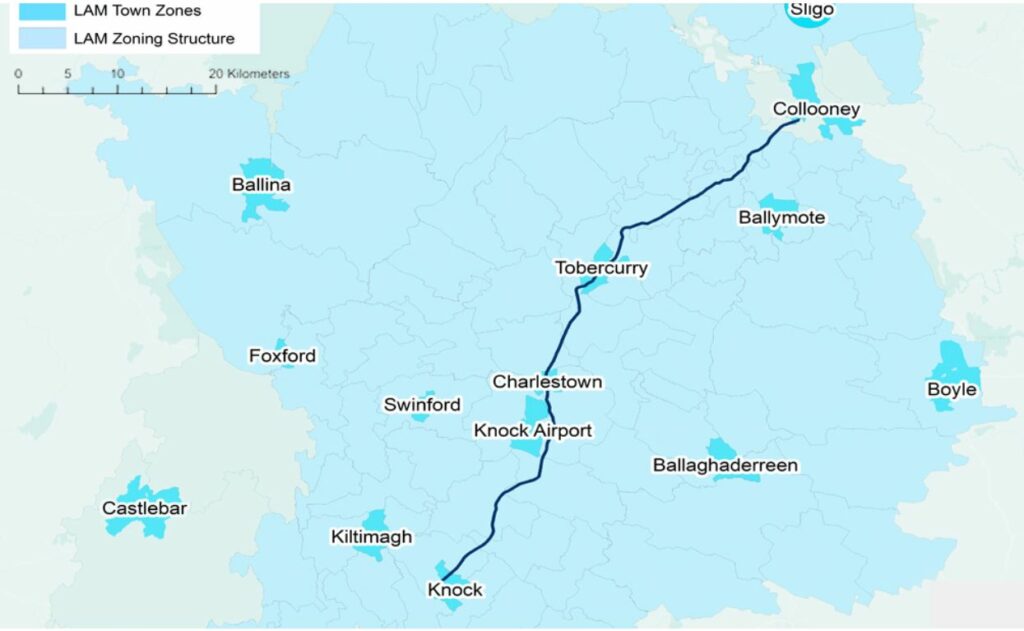Drystock farmer Michael O’Dowd often choses a Sunday morning to move his cattle.
When your 100ac farm in Achonroy, Co. Sligo – which has been in the family for more than 250 years – is split in two by the N17 road moving cattle is no simple job.
He normally has to seek up to 12 people to get the cattle from one side of the farm to the other and to navigate across the N17 road, the national, primary road which runs from Co. Galway through Co. Mayo and on to Co. Sligo.
Without a bridge or an underpass, O’Dowd has no way of bringing his cattle from one part to the next, other than walking them across the now “extremely busy” road.
The road itself has been there for more than 100 years, but it has changed immensely in O’Dowd’s lifetime. It bears little resemblance to the road he used to walk to national school in the 60s – today it is a route where daily traffic volumes exceed 10,000 units a day.
With the heavy use of the N17, plans are being developed to construct an improvied route from Knock in Co. Mayo to Collooney in Co. Sligo. However, these plans have been ongoing for 25 years, and it remains unclear where the new road will be located.
Although the growing popularity of the current road has caused a number of issues for O’Dowd, he insists that the best plan would be to upgrade the road that already runs through his farm, rather than fragment any other land parcels in the region.
Speaking to Agriland, he explained that this would be the most logical option for several reasons.
“In my own opinion, everyone is used to where the road is, because that’s where is has always been.
“The amount of land it would take to construct a completely new road, you’re talking about maybe 3,000 acres from Knock to Colooney for the project. That’s a huge amount of land that is sequestering carbon right now.
“It wouldn’t cause more fragmentation or any more splitting of farms. And it would disturb and destroy less natural habitats. “So, to improve the current road would be the best option,” he explained.
O’Dowd said that over the past ten years, farming has become tough for many with many changes, new regulations and schemes that farmers must follow. But now on top of that many farm families around him are worried “they will be walloped with a compulsory purchase order (CPO) and lose a third of their farm”.
The development process is currently at ‘Phase Two, Refinement of Feasible Options’ whereby the local authorities involved are examining which of four possible routes will be chosen to construct the road. A decision was due to be announced in 2021, however it was delayed until October 2022, before being pushed again to quarter one of 2023.

O’Dowd said everyone in the region is frustrated waiting and just want to know what will be happening and who will be affected.
He believes the planners will favour the options that extend through “virgin countryside”, as opposed to developing the existing route.
O’Dowd said that he understands that due to the volumes of traffic using the road daily upgrading it would be difficult.
However, he believes “it is still better to do the right thing and find a way to do it, than plough through more farmland”.
“When you unearth countryside you cause all sorts of problems for wildlife and nature and groundwater and everything, it’s monumental the effect of it.
“A new construction can disturb badgers and everything which brings up the risk of tuberculosis as well,” O’Dowd pointed out.
“Re-align the existing route, take out the bends, improve the junctions and make it fit for purpose, I think that is the best option.”
The urgent development of an improved railway system is also vital along these western corridors claims O’Dowd who said that many people using the road are tourists or students, who may be better suited to using trains, if they were a realistic option.
“Re-opening of the rail links [in the west] needs to happen. Especially with the carbon futures we’re talking about, cutting back on emissions and so on. The rail is way more beneficial and it’s the cheaper option as well.
“What we need is a rail circuit of the country. That would be a smaller footprint on the environment and it would facilitate other things.
“There are students in Galway where accommodation can’t be got, they could travel home to other counties if we had a rail line there,” he added.
Despite the numerous delays in the announcement of the location for the new stretch of the N17, O’Dowd is hoping that a decision will be delivered early in the new year, and said he and others in the region will have to face it, whatever it may be.
